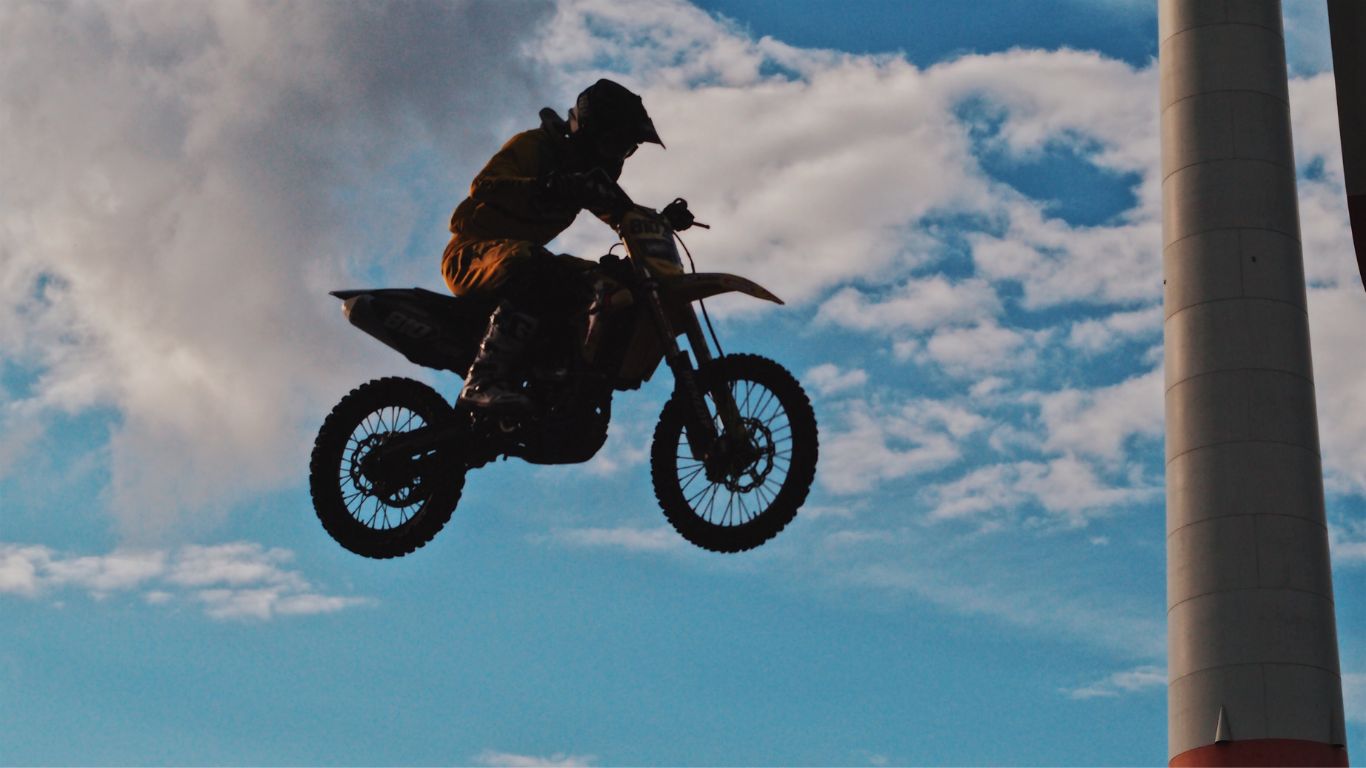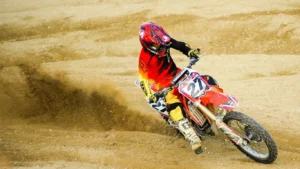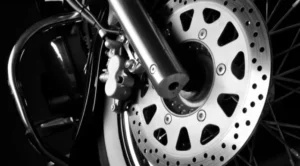An automatic dirt bike is a type of motorcycle designed for off-road riding that features an automatic transmission. Unlike a manual or semi-automatic dirt bike, an automatic dirt bike does not require the rider to shift gears or use a clutch to change gears. Instead, the bike’s transmission automatically adjusts the gear ratio based on the engine’s speed and power output.
This makes automatic dirt bikes easier to ride than manual or semi-automatic dirt bikes, and they are often preferred by beginner or inexperienced riders. The lack of a clutch and gear shifter means that the rider can focus more on controlling the bike and navigating the terrain.
However, experienced riders may find that automatic dirt bikes limit their ability to fine-tune the bike’s power output and gear selection for different riding conditions. Additionally, automatic dirt bikes can be less responsive and have less overall power compared to their manual or semi-automatic counterparts.
What is An Automatic Dirt bike?
Automatic dirt bikes are motorcycles designed for off-road use, with a transmission system that shifts gears automatically. Unlike manual dirt bikes, which require the rider to manually shift gears using a clutch and gear selector, automatic dirt bikes use a system that automatically shifts gears as the rider accelerates or decelerates.
Automatic dirt bikes are popular among beginners and riders who prefer a simpler, more user-friendly riding experience. They are also popular among younger riders, as they allow them to focus on learning basic riding skills without the added complexity of shifting gears.
There are several different types of automatic dirt bikes available on the market, ranging from small, low-powered bikes suitable for children to larger, more powerful bikes designed for experienced riders.
Some automatic dirt bikes also come equipped with additional features such as electric starters, adjustable suspension systems, and advanced braking systems to enhance their performance and safety.
Overall, automatic dirt bikes are a great option for riders looking for a more accessible, user-friendly off-road riding experience.
However, it’s important to keep in mind that riding any type of dirt bike can be dangerous, and riders should always wear appropriate safety gear and follow basic safety guidelines when riding.
How Does An Automatic Dirt Bike Work?
An automatic dirt bike works by using an automatic transmission system to shift gears, which eliminates the need for the rider to manually shift gears using a clutch and gear selector.
The transmission system in an automatic dirt bike uses a centrifugal clutch that engages automatically when the engine reaches a certain RPM.
As the rider accelerates, the transmission system automatically shifts up to a higher gear as needed, depending on the speed and power required. When the rider slows down, the transmission system shifts down to a lower gear to maintain the engine RPM and power output.
The automatic transmission system in a dirt bike typically has two to four gears, depending on the model and manufacturer. Some dirt bikes also have a manual mode, which allows the rider to manually select gears using a switch or button on the handlebars.
This can be useful when riding in certain situations, such as steep hills or technical terrain, where the rider wants more control over the gears.
Overall, automatic dirt bikes provide a simpler, more user-friendly riding experience for beginners and riders who prefer a less complex riding style. However, it’s important to keep in mind that riding any type of dirt bike can be dangerous, and riders should always wear appropriate safety gear and follow basic safety guidelines when riding.
How To Ride An Automatic Dirt Bike?
Riding an automatic dirt bike is similar to riding a manual dirt bike, but without the need to shift gears manually.
Remember to always wear appropriate safety gear, including a helmet, gloves, boots, and protective clothing, when riding an automatic dirt bike.
Here are some basic steps for riding an automatic dirt bike:
1. Familiarize yourself with the controls
Sure! Here are the basic controls that you need to familiarize yourself with before riding an automatic dirt bike:
Throttle: The throttle is located on the right handlebar and controls the speed of the bike. Twist it towards yourself to increase the speed, and release it to slow down.
Brake lever: The front brake lever is located on the right handlebar, while the rear brake lever is located on the right side of the bike near the footpeg. Squeeze the levers to apply the brakes.
Gear shifter: The gear shifter is located on the left side of the bike near the footpeg. In an automatic dirt bike, it usually has two positions: “1” and “D” for “Drive” mode. “1” is used for slow-speed riding and off-road situations, while “D” is used for higher-speed riding on smooth terrain.
Centrifugal clutch: The centrifugal clutch is located inside the engine and automatically engages when the engine RPM reaches a certain level. It disengages when the RPM drops below a certain level.
Kill switch: The kill switch is usually located on the right handlebar and is used to turn off the engine in an emergency.
Ignition switch: The ignition switch is usually located near the handlebars and is used to turn the bike on and off.
Speedometer: Some automatic dirt bikes have a speedometer that displays the current speed of the bike.
Make sure you know where all the controls are and how to operate them before you start riding your automatic dirt bike. It’s also a good idea to read the owner’s manual for your specific model to get a better understanding of its features and controls.
2. Start the engine
To start the engine of an automatic dirt bike, follow these steps:
Make sure the bike is in neutral: Before starting the engine, make sure the bike is in neutral by pulling in the clutch lever (if your bike has one) and pushing down on the gear shifter until the neutral light on the instrument panel comes on.
Turn on the ignition switch: Insert the key into the ignition switch, turn it to the “on” position, and make sure the instrument panel lights up.
Check the fuel and choke: Make sure there is enough fuel in the tank and, if your bike has a choke, make sure it is in the “on” position.
Start the engine: If your bike has an electric starter, simply press the starter button to start the engine. If your bike has a kickstarter, put your foot on the kickstarter lever and give it a firm kick. Make sure to keep your balance and hold onto the handlebars while starting the engine.
Warm up the engine: Let the engine idle for a few minutes to warm up before riding. This will help prevent engine damage and improve performance.
Once the engine is running, you can shift into “1” or “D” and start riding your automatic dirt bike. Remember to always wear appropriate safety gear, including a helmet, gloves, boots, and protective clothing, when riding.
3. Apply the brakes
To apply the brakes on an automatic dirt bike, follow these steps:
Identify the brake levers: The front brake lever is located on the right handlebar, while the rear brake lever is located on the right side of the bike near the footpeg.
Squeeze the brake lever: To apply the front brake, squeeze the front brake lever with your right hand. To apply the rear brake, press down on the rear brake lever with your right foot.
Gradually apply the brakes: Avoid grabbing or slamming on the brakes, as this can cause the bike to skid or lose control. Instead, apply the brakes gradually and smoothly to slow down or stop the bike.
Use both brakes together: For maximum stopping power, use both brakes together. Squeeze the front brake lever with your right hand while pressing down on the rear brake lever with your right foot.
Release the brakes: Once you have slowed down or come to a complete stop, release the brake lever or pedal slowly to prevent the bike from lurching forward.
Remember to use the brakes carefully and avoid locking up the wheels, as this can cause the bike to slide or lose control. With practice, you will learn how to use the brakes effectively and safely on your automatic dirt bike.
4. Shift to gear
In an automatic dirt bike, shifting gears is not necessary, as the bike is designed to shift gears automatically based on the engine RPM and speed.
However, some automatic dirt bikes may have a gear shifter that allows you to manually select a lower gear (such as “1”) for slow-speed riding and off-road situations.
To shift to a lower gear on an automatic dirt bike with a gear shifter, follow these steps:
Slow down: Before shifting to a lower gear, slow down the bike to a safe speed.
Pull in the clutch lever: If your bike has a clutch lever, pull it in to disengage the clutch.
Downshift: Press down on the gear shifter with your left foot to shift to a lower gear. On most automatic dirt bikes, there will be a “1” or “L” position for low gear.
Release the clutch: Slowly release the clutch lever while giving the bike a little gas with the throttle. This will engage the clutch and allow the bike to move forward in the lower gear.
It’s important to note that in an automatic dirt bike, the bike will automatically shift to higher gears as you increase speed. You do not need to manually shift gears as you would on a manual dirt bike.
5. Release the clutch
In an automatic dirt bike, releasing the clutch is not necessary as the bike’s transmission system automatically engages and disengages the clutch.
However, some automatic dirt bikes may have a clutch lever that can be used to manually engage and disengage the clutch, which can be useful in certain off-road riding situations.
If your automatic dirt bike has a clutch lever and you need to release the clutch to start moving, follow these steps:
Shift into gear: If your bike has a gear shifter, shift into the appropriate gear for your speed and riding conditions. Some automatic dirt bikes may have a “D” mode for regular riding and a “1” or “L” mode for slow-speed and off-road riding.
Hold in the clutch lever: Pull in the clutch lever with your left hand to disengage the clutch.
Give the bike some gas: Twist the throttle with your right hand to give the bike some gas while holding in the clutch lever.
Release the clutch lever: Slowly release the clutch lever while continuing to give the bike gas. This will engage the clutch and allow the bike to start moving.
It’s important to practice releasing the clutch gradually and smoothly to prevent stalling or jerky movements. With practice, you will become more comfortable with using the clutch lever on your automatic dirt bike.
6. Accelerate
To accelerate on an automatic dirt bike, follow these steps:
Twist the throttle: The throttle is located on the right handlebar and is typically twisted forward to increase speed. Twist the throttle slowly and smoothly to increase your speed.
Shift your weight: As you accelerate, shift your weight forward slightly to maintain balance and control over the bike. Keep your arms and legs relaxed to absorb any bumps or jumps in the terrain.
Gradually increase speed: Avoid jerky movements or sudden bursts of speed, as this can cause the bike to lose traction or control. Instead, gradually increase your speed as you become more comfortable with the bike.
Monitor your speed: Keep an eye on your speedometer or gauge to monitor your speed and ensure that you are riding at a safe and appropriate speed for the terrain and conditions.
Remember to always wear protective gear, including a helmet, gloves, boots, and body armor, when riding your automatic dirt bike. Also, be aware of your surroundings and ride at a safe and appropriate speed for the terrain and conditions. With practice and experience, you will become more comfortable and confident with accelerating on your automatic dirt bike.
7. Control the bike
To control an automatic dirt bike, follow these tips:
Balance the bike: Balance is crucial for maintaining control over your dirt bike. Keep your weight centered over the bike and use your body to adjust your balance as needed. Keep your arms and legs relaxed to absorb any bumps or jumps in the terrain.
Use the handlebars: The handlebars are used to steer the bike. Turn the handlebars in the direction you want to go, but be careful not to oversteer or turn too sharply, as this can cause the bike to lose traction or control.
Use your feet: Your feet are important for maintaining balance and control over the bike. Keep your feet on the footpegs at all times, and use your feet to stabilize the bike in corners or on uneven terrain.
Brake effectively: Use the brakes smoothly and gradually to slow down or stop the bike. Avoid grabbing or slamming on the brakes, as this can cause the bike to skid or lose control. Use both brakes together for maximum stopping power.
Use your body position: Your body position can help you maintain control over the bike and handle different riding situations. Lean forward when accelerating or climbing hills, and lean back when descending or braking. Use your body weight to counterbalance the bike in turns and over obstacles.
Monitor your speed: Keep an eye on your speedometer or gauge to ensure that you are riding at a safe and appropriate speed for the terrain and conditions. Slow down or stop the bike if necessary to avoid hazards or obstacles in your path.
8. Shift gears
In an automatic dirt bike, you do not need to shift gears manually as the transmission system automatically changes gears based on the bike’s speed and riding conditions. However, some automatic dirt bikes may have different modes or settings that can affect how the transmission behaves.
If your automatic dirt bike has a manual mode or settings, you can use the buttons or switches on the handlebars to adjust the transmission behavior. For example, you may be able to select a “1” or “L” mode for slow-speed and off-road riding, or a “D” mode for regular riding.
If you’re not sure how to shift gears on your automatic dirt bike, consult the owner’s manual or contact the manufacturer for specific instructions. In general, you can follow these tips to adjust the transmission settings on your automatic dirt bike:
Locate the mode or settings buttons: The buttons or switches that control the transmission settings are typically located on the handlebars, near the throttle and brake levers.
Consult the owner’s manual: The owner’s manual should provide specific instructions for adjusting the transmission settings on your particular automatic dirt bike. Follow the instructions carefully to avoid damaging the bike or causing unsafe riding conditions.
Test the different settings: Once you have adjusted the transmission settings, test them out in a safe and controlled environment to see how they affect the bike’s performance. Make adjustments as needed until you find the settings that work best for your riding style and conditions.
Always wear a helmet, gloves, boots, and body armor when riding your motorized dirt bike.
Also, be aware of your surroundings and ride at a safe and appropriate speed for the terrain and conditions. With practice and experience, you will become more comfortable and confident with controlling your automatic dirt bike.
9. Practice
Practice is essential to improving your riding skills and becoming more comfortable and confident on your automatic dirt bike.
Here are some tips for practicing and improving your riding:
Find a safe and appropriate practice area: Look for a location with flat and open terrain, away from obstacles and hazards. This could be an empty field or a designated off-road riding area.
Start with basic maneuvers: Begin by practicing basic maneuvers such as starting and stopping, turning, and accelerating and decelerating smoothly. Focus on developing good balance and control over the bike.
Practice different riding techniques: As you become more comfortable with the basics, practice different riding techniques such as riding in different positions (standing, sitting, leaning forward or back), riding over obstacles, and cornering.
Gradually increase speed and difficulty: Once you have mastered the basics, gradually increase your speed and difficulty level by riding over more challenging terrain and practicing more advanced riding techniques.
Seek instruction or guidance: Consider taking a riding class or getting guidance from a more experienced rider. They can offer valuable tips and advice to help you improve your riding skills.
Stay safe: Always wear protective gear, including a helmet, gloves, boots, and body armor, when riding your automatic dirt bike. Be aware of your surroundings and ride at a safe and appropriate speed for the terrain and conditions.
Remember, learning to ride an automatic dirt bike takes time, patience, and practice. With consistent practice and dedication, you can become a skilled and confident rider.
Difference between manual dirt bike and automatic dirt bike
The main difference between a manual dirt bike and an automatic dirt bike is how the rider changes gears.
In a manual dirt bike, the rider must use a clutch lever and shift gear with a foot pedal, while in an automatic dirt bike, the bike changes gears automatically.
Here are some of the main differences between manual and automatic dirt bikes:
Gearing: As mentioned, the main difference is how the bike changes gears. A manual dirt bike has a foot-operated gear shifter and a clutch lever on the handlebars, while an automatic dirt bike uses an internal mechanism to shift gears without any input from the rider.
Skill level: Because manual dirt bikes require the rider to use a clutch and shift gears manually, they require more skill and experience to operate. Automatic dirt bikes are generally considered easier to ride, making them a good choice for beginners or riders who prefer a more relaxed riding experience.
Price: Automatic dirt bikes tend to be more expensive than manual dirt bikes due to the added technology required for the automatic transmission.
Maintenance: Manual dirt bikes require more maintenance, as the clutch and transmission components will wear out over time and need to be replaced. Automatic dirt bikes have fewer moving parts and may require less maintenance.
Riding style: Manual dirt bikes are preferred by riders who enjoy more control over their riding experience, as they can manipulate the gears to suit the terrain and their riding style. Automatic dirt bikes are generally more suited to riders who prefer a more laid-back, casual riding experience.
Rider skill, riding style, and preferences will determine whether to ride a manual or automatic dirt bike.
While choosing a bike, examine its benefits and downsides.
Conclusion
Riding an automatic dirt bike can be a fun and rewarding experience for riders of all skill levels.
It’s important to start by familiarizing yourself with the controls and practicing basic maneuvers, gradually increasing speed and difficulty as you become more comfortable and confident on the bike.
Whether you choose a manual or automatic dirt bike, always prioritize safety by wearing protective gear and riding at a safe and appropriate speed for the terrain and conditions. With practice and dedication, you can become a skilled and confident rider on your automatic dirt bike.






